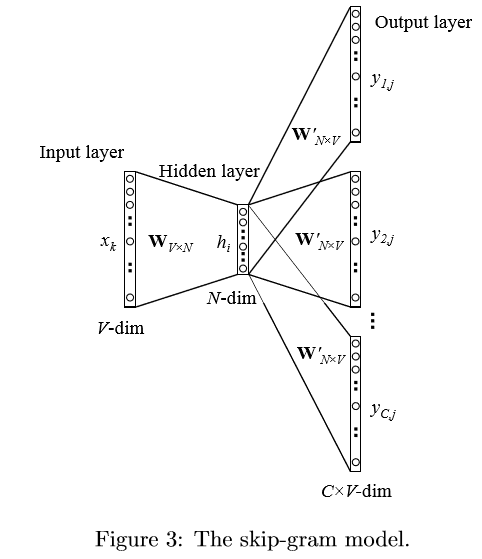SkipGram NegativeSampling implemented in PyTorch.
See test.ipynb
- Python 3
- PyTorch 1.x
- Efficient Estimation of Word Representations in Vector Space (original word2vec paper)
- Distributed Representations of Words and Phrases and their Compositionality (negative sampling paper)
Word2Vec是用无监督方式从文本中学习词向量来表征语义信息的模型,语义相近的词在嵌入空间中距离相近。类似于auto-encoder,Word2Vec训练的神经网络不用于处理新任务,真正需要的是模型参数,即隐层的权重矩阵。
Skip-gram是在给定目标单词的情况下,预测其上下文单词。
用两个word matrix,W表示目标单词向量矩阵(V*N),W'表示上下文单词向量矩阵(N*V),词向量维度N,词汇表维度V。
模型:
- 投影:$h_i=Wx_k$
- 计算相似度:$z=W'h_i$
- 转换为概率分布:$\hat y=\text{softmax}(z)$
高效训练的三个trick(来自第二篇paper):
- subsampling of the frequent words
- nagative sampling (alternative to hierarchical softmax)
- treat word pairs / phases as one word
高频词数量远超训练所需,所以进行抽样,基于词频以一定概率丢弃词汇(论文中公式): $$ P\left(w_{i}\right)=1-\sqrt{\frac{t}{f\left(w_{i}\right)}} $$
作者实际使用的公式(t默认0.0001):
负采样使得每个训练样本仅更新一小部分权重。negative word指期望概率为0的单词,选取概率为: $$ P_n(w_i)=f(w_i)^{3 / 4} / Z $$
在 text8 语料上训练,默认采用词向量维数为100,词典大小为50000,window_size为5,负采样数为10。
- 基于词向量的语言学特性
- similarity task 词相似
- analogy task 词类比 (A-B=C-D)
- Task-specific
- 对具体任务的性能提升
这里基于词相似,在 WordSim-353、Stanford Rare Word (RW) 和 SimLex-999 上利用 Spearman's rank correlation coefficient 进行评估。
训练1小时(4个epoch),尚未完全拟合的情况下效果如下。对照 Gensim Word2vec 默认训练结果和 GoogleNews-vectors-negative300 :
| WordSim353 | RW | SimLex-999 | Corpus | embed_dim | vocab_size | Time | |
|---|---|---|---|---|---|---|---|
| Gensim | 0.624 | 0.320 | 0.250 | text8 | 100 | 71290 | 1min |
| SGNS-PyTorch | 0.661 | 0.343 | 0.265 | text8 | 100 | 50000 | 1h |
| GoogleNews | 0.659 | 0.553 | 0.436 | GoogleNews | 300 | 3000000 | - |
测试过程和结果在 test.ipynb
